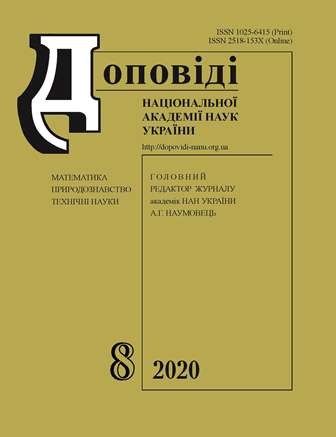Залучення оксиду азоту до відповіді мікротрубочок рослинної клітини на дію високої температури
DOI:
https://doi.org/10.15407/dopovidi2020.08.066Ключові слова:
cPTIO, донор NO, мікротрубочки, нітропрусид натрію, оксид азоту (NO), скавенджер NO, тепловий стресАнотація
Досліджено вплив донора (нітропрусид натрію (SNP)) і скавенджера (карбокси-2-феніл-4,4,5,5-тетраметитімідазолін-1-оксил-3-oксид (cPTIO)) оксиду азоту (NO) на теплостійкість проростків Arabidopsis thaliana за участю мікротрубочок як важливого посередника в реалізації дії високої температури на рослинну клітину. Експозиція проростків при температурі 41 °С призводила до значних змін вихідної організації мікротрубочок, що проявлялись в їх деполімеризації та фрагментації. Показано, що застосуваня донора оксиду азоту SNP за умов теплового стресу, яке має спричиняти підвищення рівня ендогенного NO, сприяє збереженню структурної цілісності мікротрубочок під дією високої температури, тоді як використання ска венджера оксиду азоту cPTIO зумовлює зворотні ефекти. Встановлені закономірності змін організації мікротрубочок можуть розглядатися як важливий елемент внутрішньоклітинних механізмів інгібування росту головного кореня під впливом високих температур і відновлення цих процесів шляхом індукції внутрішньоклітинних сигнальних шляхів за участю NO.
Завантаження
Посилання
Simontacchi, M., Galatro, A., Ramos-Artuso, F. & Santa-Marіa, G.E. (2015). Plant survival in a changing environment: the role of nitric oxide in plant responses to abiotic stress. Front. Plant Sci., 6, рр. 977. https://doi.org/10.3389/fpls.2015. 00977
Asgher, M., Per, T. S., Masood, A., Fatma, M., Freschi, L., Corpas, F. J. & Khan, N. A. (2017). Nitric oxide signaling and its crosstalk with other plant growth regulators in plant responses to abiotic stress. Environ. Sci. Pollut. Res., 24, pp. 2273-2285. https://doi.org/10.1007/ s11356-016-7947-8
Hasanuzzaman, M., Oku, H., Nahar, K., Borhannuddin Bhuyan, M. H. M., Al Mahmud, J., Baluska, F. & Fujita, M. (2018). Nitric oxide-induced salt stress tolerance in plants: ROS metabolism, signaling, and molecular interactions. Plant Biotechnol. Rep., 12, No. 2, pp. 77-92. https://doi.org/10.1007/s11816-018-0480-0
Krasylenko, Yu. A., Yemets, A. I. & Blume, Ya. B. (2017). Cell mechanisms of nitric oxide signaling in plants under abiotic stress conditions. In Pandey, G. (Ed.). Mechanism of plant hormone signaling under stress: a functional genomic frontier. (Vol. 1) (pp. 371-398). Hoboken, NJ: Wiley-Blackwell. https://doi.org/10.1002/9781118889022.ch15
Hasanuzzaman, M., Nahar, K., Alam, M. M., Roychowdhury, R. & Fujita, M. (2013). Physiological, bioche mical, and molecular mechanisms of heat stress tolerance in plants. Int. J. Mol. Sci., 14, pp. 9643-9684. https://doi.org/10.3390/ijms14059643
Deng, Z. & Song, S. (2012). Sodium nitroprusside, ferricyanide, nitrite and nitrate decrease the thermodormancy of lettuce seed germination in a nitric oxide-dependent manner in light. South Afr. J. Bot., 78, pp. 139-146. https://doi.org/10.1016/j.sajb.2011.06.009
Song, L. & Hou, M. (2013). Involvement of nitric oxide in acquired thermotolerance of rice seedlings. Russ. J. Plant Physiol., 60, pp. 785-790. https://doi.org/10.1134/ S1021443713060149
Plohovska, S. G., Krasylenko, Yu. A. & Yemets, A. I. (2019). Low temperature effects on actin filament organization in Arabidopsis thaliana primary root cells. Cell. Biol. Int., 43, No. 9, pp. 1020-1030. https://doi.org/10.1002/cbin. 10931
Koutalianou, M., Orfanidis, S. & Katsaros, C. (2016). Effects of high temperature on the ultrastructure and microtubule organization of interphase and dividing cells of the seagrass Cymodocea nodosa. Protoplasma., 253, pp. 299-310. https://doi.org/10.1007/s00709-015-0809-2
Plohovska, S. G. Yemets, A. I. & Blume, Ya. B. (2016). Influence of cold on organization of actin filaments of different types of root cells in Arabidopsis thaliana. Cytol. Genet., 50, No. 5, pp. 318-323. https://doi.org/10.3103/ S0095452716050108
Krasylenko, Y. A., Yemets, A. I., Sheremet, Y. A. & Blume, Ya. B. (2012). Nitric oxide as a critical factor for perception of UV-B irradiation by microtubules in Arabidopsis. Physiol. Plant, 145, рр. 505-515. https://doi.org/10.1111/j.1399-3054.2011.01530.x
Karpets, Y. V., Kolupaev, Y. E. & Yastreb, T. O. (2011). Effect of sodium nitroprusside on heat resistance of wheat coleoptiles: dependence on the formation and scavenging of reactive oxygen species. Russ. J. Plant Physiol, 58, рр. 1027-1033. https://doi.org/10.1134/S1021443711060094
El-Beltagi, H. S., Ahmed, O. K. & Hegazy, A. E. (2016). Protective effect of nitric oxide on high temperature induced oxidative stress in wheat (Triticum aestivum) callus culture. Not. Sci. Biol., 8, No. 2, pp. 192-198. https://doi.org/10.15835/nsb829807
Karpets, Yu. V., Kolupaev, Yu. E. & Vayner, A. A. (2015). Functional interaction between nitric oxide and hydrogen peroxide during formation of wheat seedling induced heat resistance. Russ. J. Plant Physiol., 62, pp. 65-70. https://doi.org/10.1134/S1021443714060090
Uchida, A., Jagendorf, A. T., Hibino, T., Takabe, T. & Takabe, T. (2002). Effects of hydrogen peroxide and nitric oxide on both salt and heat stress tolerance in rice. Plant Science., 163, pp. 515-523. https://doi.org/10.1016/S0168-9452(02)00159-0
##submission.downloads##
Опубліковано
Як цитувати
Номер
Розділ
Ліцензія
Авторське право (c) 2023 Доповіді Національної академії наук України

Ця робота ліцензується відповідно до Creative Commons Attribution-NonCommercial 4.0 International License.




